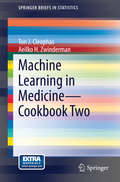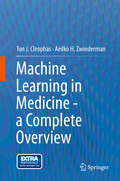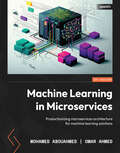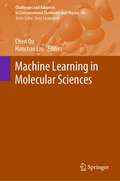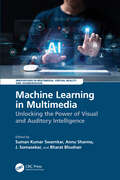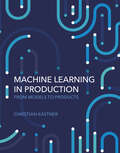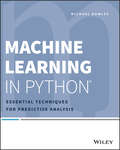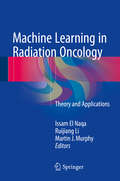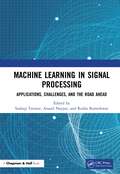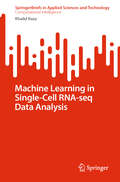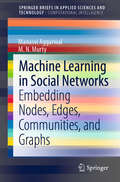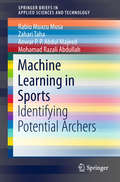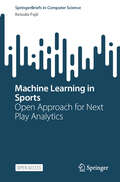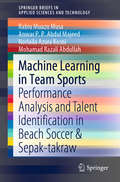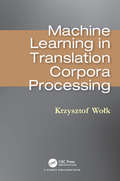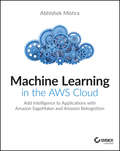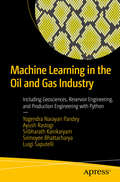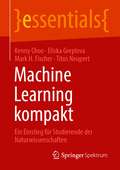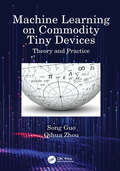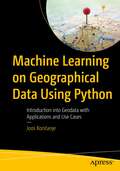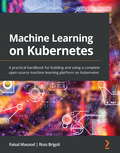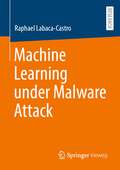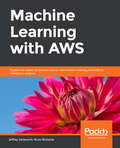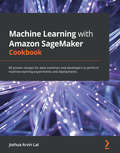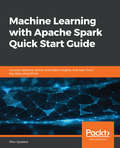- Table View
- List View
Machine Learning in Medicine - Cookbook Two
by Aeilko H. Zwinderman Ton J. CleophasThe amount of data medical databases doubles every 20 months, and physicians are at a loss to analyze them. Also, traditional data analysis has difficulty to identify outliers and patterns in big data and data with multiple exposure / outcome variables and analysis-rules for surveys and questionnaires, currently common methods of data collection, are, essentially, missing. Consequently, proper data-based health decisions will soon be impossible. Obviously, it is time that medical and health professionals mastered their reluctance to use machine learning methods and this was the main incentive for the authors to complete a series of three textbooks entitled "Machine Learning in Medicine Part One, Two and Three, Springer Heidelberg Germany, 2012-2013", describing in a nonmathematical way over sixty machine learning methodologies, as available in SPSS statistical software and other major software programs. Although well received, it came to our attention that physicians and students often lacked time to read the entire books, and requested a small book, without background information and theoretical discussions and highlighting technical details. For this reason we produced a 100 page cookbook, entitled "Machine Learning in Medicine - Cookbook One", with data examples available at extras. springer. com for self-assessment and with reference to the above textbooks for background information. Already at the completion of this cookbook we came to realize, that many essential methods were not covered. The current volume, entitled "Machine Learning in Medicine - Cookbook Two" is complementary to the first and also intended for providing a more balanced view of the field and thus, as a must-read not only for physicians and students, but also for any one involved in the process and progress of health and health care. Similarly to Machine Learning in Medicine - Cookbook One, the current work will describe stepwise analyses of over twenty machine learning methods, that are, likewise, based on the three major machine learning methodologies: Cluster methodologies (Chaps. 1-3) Linear methodologies (Chaps. 4-11) Rules methodologies (Chaps. 12-20) In extras. springer. com the data files of the examples are given, as well as XML (Extended Mark up Language), SPS (Syntax) and ZIP (compressed) files for outcome predictions in future patients. In addition to condensed versions of the methods, fully described in the above three textbooks, an introduction is given to SPSS Modeler (SPSS' data mining workbench) in the Chaps. 15, 18, 19, while improved statistical methods like various automated analyses and Monte Carlo simulation models are in the Chaps. 1, 5, 7 and 8. We should emphasize that all of the methods described have been successfully applied in practice by the authors, both of them professors in applied statistics and machine learning at the European Community College of Pharmaceutical Medicine in Lyon France. We recommend the current work not only as a training companion to investigators and students, because of plenty of step by step analyses given, but also as a brief introductory text to jaded clinicians new to the methods. For the latter purpose, background and theoretical information have been replaced with the appropriate references to the above textbooks, while single sections addressing "general purposes", "main scientific questions" and "conclusions" are given in place. Finally, we will demonstrate that modern machine learning performs sometimes better than traditional statistics does. Machine learning may have little options for adjusting confounding and interaction, but you can add propensity scores and interaction variables to almost any machine learning method.
Machine Learning in Medicine - a Complete Overview
by Aeilko H. Zwinderman Ton J. CleophasThe current book is the first publication of a complete overview of machine learning methodologies for the medical and health sector. It was written as a training companion and as a must-read, not only for physicians and students, but also for any one involved in the process and progress of health and health care. In eighty chapters eighty different machine learning methodologies are reviewed, in combination with data examples for self-assessment. Each chapter can be studied without the need to consult other chapters. The amount of data stored in the world's databases doubles every 20 months, and clinicians, familiar with traditional statistical methods, are at a loss to analyze them. Traditional methods have, indeed, difficulty to identify outliers in large datasets, and to find patterns in big data and data with multiple exposure / outcome variables. In addition, analysis-rules for surveys and questionnaires, which are currently common methods of data collection, are, essentially, missing. Fortunately, the new discipline, machine learning, is able to cover all of these limitations. So far medical professionals have been rather reluctant to use machine learning. Also, in the field of diagnosis making, few doctors may want a computer checking them, are interested in collaboration with a computer or with computer engineers. Adequate health and health care will, however, soon be impossible without proper data supervision from modern machine learning methodologies like cluster models, neural networks and other data mining methodologies. Each chapter starts with purposes and scientific questions. Then, step-by-step analyses, using data examples, are given. Finally, a paragraph with conclusion, and references to the corresponding sites of three introductory textbooks, previously written by the same authors, is given.
Machine Learning in Microservices: Productionizing microservices architecture for machine learning solutions
by Omar Ahmed Mohamed AbouahmedImplement real-world machine learning in a microservices architecture as well as design, build, and deploy intelligent microservices systems using examples and case studiesPurchase of the print or Kindle book includes a free PDF eBookKey FeaturesDesign, build, and run microservices systems that utilize the full potential of machine learningDiscover the latest models and techniques for combining microservices and machine learning to create scalable systemsImplement machine learning in microservices architecture using open source applications with pros and consBook DescriptionWith the rising need for agile development and very short time-to-market system deployments, incorporating machine learning algorithms into decoupled fine-grained microservices systems provides the perfect technology mix for modern systems. Machine Learning in Microservices is your essential guide to staying ahead of the curve in this ever-evolving world of technology.The book starts by introducing you to the concept of machine learning microservices architecture (MSA) and comparing MSA with service-based and event-driven architectures, along with how to transition into MSA. Next, you'll learn about the different approaches to building MSA and find out how to overcome common practical challenges faced in MSA design. As you advance, you'll get to grips with machine learning (ML) concepts and see how they can help better design and run MSA systems. Finally, the book will take you through practical examples and open source applications that will help you build and run highly efficient, agile microservices systems.By the end of this microservices book, you'll have a clear idea of different models of microservices architecture and machine learning and be able to combine both technologies to deliver a flexible and highly scalable enterprise system.What you will learnRecognize the importance of MSA and ML and deploy both technologies in enterprise systemsExplore MSA enterprise systems and their general practical challengesDiscover how to design and develop microservices architectureUnderstand the different AI algorithms, types, and models and how they can be applied to MSAIdentify and overcome common MSA deployment challenges using AI and ML algorithmsExplore general open source and commercial tools commonly used in MSA enterprise systemsWho this book is forThis book is for machine learning solution architects, system and machine learning developers, and system and solution integrators of private and public sector organizations. Basic knowledge of DevOps, system architecture, and artificial intelligence (AI) systems is assumed, and working knowledge of the Python programming language is highly desired.
Machine Learning in Molecular Sciences (Challenges and Advances in Computational Chemistry and Physics #36)
by Chen Qu Hanchao LiuMachine learning and artificial intelligence have propelled research across various molecular science disciplines thanks to the rapid progress in computing hardware, algorithms, and data accumulation. This book presents recent machine learning applications in the broad research field of molecular sciences. Written by an international group of renowned experts, this edited volume covers both the machine learning methodologies and state-of-the-art machine learning applications in a wide range of topics in molecular sciences, from electronic structure theory to nuclear dynamics of small molecules, to the design and synthesis of large organic and biological molecules. This book is a valuable resource for researchers and students interested in applying machine learning in the research of molecular sciences.
Machine Learning in Multimedia: Unlocking the Power of Visual and Auditory Intelligence (Innovations in Multimedia, Virtual Reality and Augmentation)
by Bharat Bhushan Suman Kumar Swarnkar Annu Sharma J. SomasekarThis book explores the interdisciplinary nature of machine learning in multimedia, highlighting its intersections with fields such as computer vision, natural language processing, and audio signal processing.Machine Learning in Multimedia: Unlocking the Power of Visual and Auditory Intelligence serves as a comprehensive guide to navigating this exciting terrain where artificial intelligence meets the rich tapestry of visual and auditory data. At its core, this book seeks to unravel the mysteries and unveil the potential of machine learning in the realm of multimedia. Whether it's enhancing user experiences in virtual environments, revolutionizing medical diagnostics, or shaping the future of entertainment, the impact of machine learning in multimedia is profound and far-reaching. The journey begins with a thorough exploration of the foundational principles of machine learning, providing readers with a solid understanding of algorithms, models, and techniques tailored specifically for multimedia data. Through clear explanations and illustrative examples, readers will gain insights into how machine learning algorithms can be trained to extract meaningful patterns and insights from diverse forms of multimedia content. Moving beyond theory, this book delves into practical implementations and real-world applications of machine learning in multimedia. Through a series of case studies and examples, readers will witness firsthand how machine learning algorithms are transforming industries and reshaping the way we interact with multimedia content. Whether it's improving image recognition accuracy in autonomous vehicles, enabling personalized recommendations in streaming platforms, or enhancing speech recognition systems for better accessibility, the possibilities are limitless.This book will be helpful to computer science, data science, and artificial intelligence researchers, students, and professionals looking to unlock the full potential of visual and auditory intelligence through the power of machine learning.
Machine Learning in Production: From Models to Products
by Christian KastnerA practical and innovative textbook detailing how to build real-world software products with machine learning components, not just models.Traditional machine learning texts focus on how to train and evaluate the machine learning model, while MLOps books focus on how to streamline model development and deployment. But neither focus on how to build actual products that deliver value to users. This practical textbook, by contrast, details how to responsibly build products with machine learning components, covering the entire development lifecycle from requirements and design to quality assurance and operations. Machine Learning in Production brings an engineering mindset to the challenge of building systems that are usable, reliable, scalable, and safe within the context of real-world conditions of uncertainty, incomplete information, and resource constraints. Based on the author’s popular class at Carnegie Mellon, this pioneering book integrates foundational knowledge in software engineering and machine learning to provide the holistic view needed to create not only prototype models but production-ready systems. • Integrates coverage of cutting-edge research, existing tools, and real-world applications• Provides students and professionals with an engineering view for production-ready machine learning systems• Proven in the classroom• Offers supplemental resources including slides, videos, exams, and further readings
Machine Learning in Python: Essential Techniques For Predictive Analysis
by Michael BowlesLearn a simpler and more effective way to analyze data and predict outcomes with Python<P><P> Machine Learning in Python shows you how to successfully analyze data using only two core machine learning algorithms, and how to apply them using Python. By focusing on two algorithm families that effectively predict outcomes, this book is able to provide full descriptions of the mechanisms at work, and the examples that illustrate the machinery with specific, hackable code. The algorithms are explained in simple terms with no complex math and applied using Python, with guidance on algorithm selection, data preparation, and using the trained models in practice. You will learn a core set of Python programming techniques, various methods of building predictive models, and howto measure the performance of each model to ensure that the right one is used. The chapters on penalized linear regression and ensemble methods dive deep into each of the algorithms, and you can use the sample code in the book to develop your own data analysis solutions.<P> Machine learning algorithms are at the core of data analytics and visualization.<P> In the past, these methods required a deep background in math and statistics, often in combination with the specialized R programming language. This book demonstrates how machine learning can be implemented using the more widely used and accessible Python programming language. <P> * Predict outcomes using linear and ensemble algorithm families <P> * Build predictive models that solve a range of simple and complex problems <P> * Apply core machine learning algorithms using Python <P> * Use sample code directly to build custom solutions<P> Machine learning doesn't have to be complex and highly specialized. Python makes this technology more accessible to a much wider audience, using methods that are simpler, effective, and well tested. Machine Learning in Python shows you how to do this,without requiring an extensive background in math or statistics.
Machine Learning in Radiation Oncology
by Issam El Naqa Ruijiang Li Martin J. MurphyThis book provides a complete overview of the role of machine learning in radiation oncology and medical physics, covering basic theory, methods, and a variety of applications in medical physics and radiotherapy. An introductory section explains machine learning, reviews supervised and unsupervised learning methods, discusses performance evaluation, and summarizes potential applications in radiation oncology. Detailed individual sections are then devoted to the use of machine learning in quality assurance; computer-aided detection, including treatment planning and contouring; image-guided radiotherapy; respiratory motion management; and treatment response modeling and outcome prediction. The book will be invaluable for students and residents in medical physics and radiation oncology and will also appeal to more experienced practitioners and researchers and members of applied machine learning communities.
Machine Learning in Signal Processing: Applications, Challenges, and the Road Ahead
by Sudeep TanwarMachine Learning in Signal Processing: Applications, Challenges, and the Road Ahead offers a comprehensive approach toward research orientation for familiarizing signal processing (SP) concepts to machine learning (ML). ML, as the driving force of the wave of artificial intelligence (AI), provides powerful solutions to many real-world technical and scientific challenges. This book will present the most recent and exciting advances in signal processing for ML. The focus is on understanding the contributions of signal processing and ML, and its aim to solve some of the biggest challenges in AI and ML. FEATURES Focuses on addressing the missing connection between signal processing and ML Provides a one-stop guide reference for readers Oriented toward material and flow with regards to general introduction and technical aspects Comprehensively elaborates on the material with examples and diagrams This book is a complete resource designed exclusively for advanced undergraduate students, post-graduate students, research scholars, faculties, and academicians of computer science and engineering, computer science and applications, and electronics and telecommunication engineering.
Machine Learning in Single-Cell RNA-seq Data Analysis (SpringerBriefs in Applied Sciences and Technology)
by Khalid RazaThis book provides a concise guide tailored for researchers, bioinformaticians, and enthusiasts eager to unravel the mysteries hidden within single-cell RNA sequencing (scRNA-seq) data using cutting-edge machine learning techniques. The advent of scRNA-seq technology has revolutionized our understanding of cellular diversity and function, offering unprecedented insights into the intricate tapestry of gene expression at the single-cell level. However, the deluge of data generated by these experiments presents a formidable challenge, demanding advanced analytical tools, methodologies, and skills for meaningful interpretation. This book bridges the gap between traditional bioinformatics and the evolving landscape of machine learning. Authored by seasoned experts at the intersection of genomics and artificial intelligence, this book serves as a roadmap for leveraging machine learning algorithms to extract meaningful patterns and uncover hidden biological insights within scRNA-seq datasets.
Machine Learning in Social Networks: Embedding Nodes, Edges, Communities, and Graphs (SpringerBriefs in Applied Sciences and Technology)
by M.N. Murty Manasvi AggarwalThis book deals with network representation learning. It deals with embedding nodes, edges, subgraphs and graphs. There is a growing interest in understanding complex systems in different domains including health, education, agriculture and transportation. Such complex systems are analyzed by modeling, using networks that are aptly called complex networks. Networks are becoming ubiquitous as they can represent many real-world relational data, for instance, information networks, molecular structures, telecommunication networks and protein–protein interaction networks. Analysis of these networks provides advantages in many fields such as recommendation (recommending friends in a social network), biological field (deducing connections between proteins for treating new diseases) and community detection (grouping users of a social network according to their interests) by leveraging the latent information of networks. An active and important area of current interest is to come out with algorithms that learn features by embedding nodes or (sub)graphs into a vector space. These tasks come under the broad umbrella of representation learning. A representation learning model learns a mapping function that transforms the graphs' structure information to a low-/high-dimension vector space maintaining all the relevant properties.
Machine Learning in Sports: Identifying Potential Archers (SpringerBriefs in Applied Sciences and Technology)
by Zahari Taha Rabiu Muazu Musa Mohamad Razali Abdullah Anwar P.P.Abdul MajeedThis brief highlights the association of different performance variables that influences archery performance and the employment of different machine learning algorithms in the identification of potential archers. The sport of archery is often associated with a myriad of performance indicators namely bio-physiological, psychological, anthropometric as well as physical fitness. Traditionally, the determination of potential archers is carried out by means of conventional statistical techniques. Nonetheless, such methods often fall short in associating non-linear relationships between the variables. This book explores the notion of machine learning that is capable of mitigating the aforesaid issue. This book is valuable for coaches and managers in identifying potential archers during talent identification programs.
Machine Learning in Sports: Open Approach for Next Play Analytics (SpringerBriefs in Computer Science)
by Keisuke FujiiThis open access book provides cutting-edge work on machine learning in sports analytics, emphasizing the integration of computer vision, data analytics, and machine learning to redefine strategic sports analysis. This book not only covers the essential methodologies of capturing and analyzing real sports data but also pioneers the integration of real-world analytics with digital modeling, advancing the field toward sophisticated digital modeling in sports. Through a seamless blend of theoretical frameworks and practical applications, the book illustrates how these integrated technologies can be utilized to predict, evaluate, and suggest next plays in sports. By leveraging the power of machine learning, the book presents cutting-edge approaches to sports analytics, where data from actual games is enhanced with predictive simulations for strategic planning and decision-making. The use of digital modeling in sports opens up new dimensions of interaction between the physical play and its digital analysis, offering a comprehensive understanding that was previously unattainable. This book is an essential read for postgraduates, researchers, and technologists, who are interested in sports analysts. The book consists of five parts: Part I, which comprises a single chapter exploring the fundamentals and scope of learning-based sports analytics; Parts II, III, IV, and V review the various aspects of this field, including data acquisition with computer vision, predictive analysis and play evaluation with machine learning, potential play evaluation with learning-based agent modeling, and future perspectives and ecosystems on the field. This structure provides a comprehensive overview that will engage and inform researchers and practitioners interested in the intersection of analytical research and cutting-edge technology in sports.
Machine Learning in Team Sports: Performance Analysis and Talent Identification in Beach Soccer & Sepak-takraw (SpringerBriefs in Applied Sciences and Technology)
by Mohamad Razali Abdullah Rabiu Muazu Musa Anwar P.P. Abdul Majeed Norlaila Azura KosniThis brief highlights the application of performance analysis tools in data acquisition, and various machine learning algorithms for evaluating team performance as well as talent identification in beach soccer and sepak takraw. Numerous performance indicators and human performance parameters are considered based on their relevance to each sport. The findings presented here demonstrate that the key performance indicators as well as human performance parameters can be used in the future evaluation of team performance as well as talent identification in these sports. Accordingly, they offer a valuable resource for coaches, club managers, talent identification experts, performance analysts and other relevant stakeholders involved in performance assessments.
Machine Learning in Translation Corpora Processing
by Krzysztof WolkThis book reviews ways to improve statistical machine speech translation between Polish and English. Research has been conducted mostly on dictionary-based, rule-based, and syntax-based, machine translation techniques. Most popular methodologies and tools are not well-suited for the Polish language and therefore require adaptation, and language resources are lacking in parallel and monolingual data. The main objective of this volume to develop an automatic and robust Polish-to-English translation system to meet specific translation requirements and to develop bilingual textual resources by mining comparable corpora.
Machine Learning in the AWS Cloud: Add Intelligence to Applications with Amazon SageMaker and Amazon Rekognition
by Abhishek MishraPut the power of AWS Cloud machine learning services to work in your business and commercial applications! Machine Learning in the AWS Cloud introduces readers to the machine learning (ML) capabilities of the Amazon Web Services ecosystem and provides practical examples to solve real-world regression and classification problems. While readers do not need prior ML experience, they are expected to have some knowledge of Python and a basic knowledge of Amazon Web Services. Part One introduces readers to fundamental machine learning concepts. You will learn about the types of ML systems, how they are used, and challenges you may face with ML solutions. Part Two focuses on machine learning services provided by Amazon Web Services. You’ll be introduced to the basics of cloud computing and AWS offerings in the cloud-based machine learning space. Then you’ll learn to use Amazon Machine Learning to solve a simpler class of machine learning problems, and Amazon SageMaker to solve more complex problems. • Learn techniques that allow you to preprocess data, basic feature engineering, visualizing data, and model building • Discover common neural network frameworks with Amazon SageMaker • Solve computer vision problems with Amazon Rekognition • Benefit from illustrations, source code examples, and sidebars in each chapter The book appeals to both Python developers and technical/solution architects. Developers will find concrete examples that show them how to perform common ML tasks with Python on AWS. Technical/solution architects will find useful information on the machine learning capabilities of the AWS ecosystem.
Machine Learning in the Oil and Gas Industry: Including Geosciences, Reservoir Engineering, and Production Engineering with Python
by Yogendra Narayan Pandey Ayush Rastogi Sribharath Kainkaryam Srimoyee Bhattacharya Luigi SaputelliApply machine and deep learning to solve some of the challenges in the oil and gas industry. The book begins with a brief discussion of the oil and gas exploration and production life cycle in the context of data flow through the different stages of industry operations. This leads to a survey of some interesting problems, which are good candidates for applying machine and deep learning approaches. The initial chapters provide a primer on the Python programming language used for implementing the algorithms; this is followed by an overview of supervised and unsupervised machine learning concepts. The authors provide industry examples using open source data sets along with practical explanations of the algorithms, without diving too deep into the theoretical aspects of the algorithms employed. Machine Learning in the Oil and Gas Industry covers problems encompassing diverse industry topics, including geophysics (seismic interpretation), geological modeling, reservoir engineering, and production engineering. Throughout the book, the emphasis is on providing a practical approach with step-by-step explanations and code examples for implementing machine and deep learning algorithms for solving real-life problems in the oil and gas industry. What You Will Learn Understanding the end-to-end industry life cycle and flow of data in the industrial operations of the oil and gas industry Get the basic concepts of computer programming and machine and deep learning required for implementing the algorithms used Study interesting industry problems that are good candidates for being solved by machine and deep learning Discover the practical considerations and challenges for executing machine and deep learning projects in the oil and gas industry Who This Book Is For Professionals in the oil and gas industry who can benefit from a practical understanding of the machine and deep learning approach to solving real-life problems.
Machine Learning kompakt: Ein Einstieg für Studierende der Naturwissenschaften (essentials)
by Kenny Choo Eliska Greplova Mark H. Fischer Titus NeupertDieses essential befasst sich mit Anwendungen des maschinellen Lernens in verschiedenen Bereichen der Naturwissenschaften. Es behandelt geläufige Strukturen und Algorithmen, um Daten mit den Techniken des maschinellen Lernens zu analysieren. Zunächst werden Methoden eingeführt, die an klassischen statistischen Analysen andocken und auf soliderem mathematischem Fundament stehen. Die Autoren machen mit den verschiedenen Strukturen für künstliche neuronale Netzwerke vertraut und zeigen die jeweiligen Anwendungsgebiete.
Machine Learning on Commodity Tiny Devices: Theory and Practice
by Song Guo Qihua ZhouThis book aims at the tiny machine learning (TinyML) software and hardware synergy for edge intelligence applications. It presents on-device learning techniques covering model-level neural network design, algorithm-level training optimization, and hardware-level instruction acceleration.Analyzing the limitations of conventional in-cloud computing would reveal that on-device learning is a promising research direction to meet the requirements of edge intelligence applications. As to the cutting-edge research of TinyML, implementing a high-efficiency learning framework and enabling system-level acceleration is one of the most fundamental issues. This book presents a comprehensive discussion of the latest research progress and provides system-level insights on designing TinyML frameworks, including neural network design, training algorithm optimization and domain-specific hardware acceleration. It identifies the main challenges when deploying TinyML tasks in the real world and guides the researchers to deploy a reliable learning system.This volume will be of interest to students and scholars in the field of edge intelligence, especially to those with sufficient professional Edge AI skills. It will also be an excellent guide for researchers to implement high-performance TinyML systems.
Machine Learning on Geographical Data Using Python: Introduction into Geodata with Applications and Use Cases
by Joos KorstanjeGet up and running with the basics of geographic information systems (GIS), geospatial analysis, and machine learning on spatial data in Python. This book starts with an introduction to geodata and covers topics such as GIS and common tools, standard formats of geographical data, and an overview of Python tools for geodata. Specifics and difficulties one may encounter when using geographical data are discussed: from coordinate systems and map projections to different geodata formats and types such as points, lines, polygons, and rasters. Analytics operations typically applied to geodata are explained such as clipping, intersecting, buffering, merging, dissolving, and erasing, with implementations in Python. Use cases and examples are included. The book also focuses on applying more advanced machine learning approaches to geographical data and presents interpolation, classification, regression, and clustering via examples and use cases. This book is your go-to resource for machine learning on geodata. It presents the basics of working with spatial data and advanced applications. Examples are presented using code (accessible at github.com/Apress/machine-learning-geographic-data-python) and facilitate learning by application.What You Will LearnUnderstand the fundamental concepts of working with geodataWork with multiple geographical data types and file formats in PythonCreate maps in PythonApply machine learning on geographical data Who This Book Is ForReaders with a basic understanding of machine learning who wish to extend their skill set to analysis of and machine learning on spatial data while remaining in a common data science Python environment
Machine Learning on Kubernetes: A practical handbook for building and using a complete open source machine learning platform on Kubernetes
by Faisal Masood Ross BrigoliBuild a Kubernetes-based self-serving, agile data science and machine learning ecosystem for your organization using reliable and secure open source technologiesKey FeaturesBuild a complete machine learning platform on KubernetesImprove the agility and velocity of your team by adopting the self-service capabilities of the platformReduce time-to-market by automating data pipelines and model training and deploymentBook DescriptionMLOps is an emerging field that aims to bring repeatability, automation, and standardization of the software engineering domain to data science and machine learning engineering. By implementing MLOps with Kubernetes, data scientists, IT professionals, and data engineers can collaborate and build machine learning solutions that deliver business value for their organization.You'll begin by understanding the different components of a machine learning project. Then, you'll design and build a practical end-to-end machine learning project using open source software. As you progress, you'll understand the basics of MLOps and the value it can bring to machine learning projects. You will also gain experience in building, configuring, and using an open source, containerized machine learning platform. In later chapters, you will prepare data, build and deploy machine learning models, and automate workflow tasks using the same platform. Finally, the exercises in this book will help you get hands-on experience in Kubernetes and open source tools, such as JupyterHub, MLflow, and Airflow.By the end of this book, you'll have learned how to effectively build, train, and deploy a machine learning model using the machine learning platform you built.What you will learnUnderstand the different stages of a machine learning projectUse open source software to build a machine learning platform on KubernetesImplement a complete ML project using the machine learning platform presented in this bookImprove on your organization's collaborative journey toward machine learningDiscover how to use the platform as a data engineer, ML engineer, or data scientistFind out how to apply machine learning to solve real business problemsWho this book is forThis book is for data scientists, data engineers, IT platform owners, AI product owners, and data architects who want to build their own platform for ML development. Although this book starts with the basics, a solid understanding of Python and Kubernetes, along with knowledge of the basic concepts of data science and data engineering will help you grasp the topics covered in this book in a better way.
Machine Learning under Malware Attack
by Raphael Labaca CastroMachine learning has become key in supporting decision-making processes across a wide array of applications, ranging from autonomous vehicles to malware detection. However, while highly accurate, these algorithms have been shown to exhibit vulnerabilities, in which they could be deceived to return preferred predictions. Therefore, carefully crafted adversarial objects may impact the trust of machine learning systems compromising the reliability of their predictions, irrespective of the field in which they are deployed. The goal of this book is to improve the understanding of adversarial attacks, particularly in the malware context, and leverage the knowledge to explore defenses against adaptive adversaries. Furthermore, to study systemic weaknesses that can improve the resilience of machine learning models.
Machine Learning with AWS: Explore the power of cloud services for your machine learning and artificial intelligence projects
by Jeffrey Jackovich Ruze RichardsUse artificial intelligence and machine learning on AWS to create engaging applicationsKey FeaturesExplore popular AI and ML services with their underlying algorithmsUse the AWS environment to manage your AI workflowReinforce key concepts with hands-on exercises using real-world datasetsBook DescriptionMachine Learning with AWS is the right place to start if you are a beginner interested in learning useful artificial intelligence (AI) and machine learning skills using Amazon Web Services (AWS), the most popular and powerful cloud platform. You will learn how to use AWS to transform your projects into apps that work at high speed and are highly scalable. From natural language processing (NLP) applications, such as language translation and understanding news articles and other text sources, to creating chatbots with both voice and text interfaces, you will learn all that there is to know about using AWS to your advantage. You will also understand how to process huge numbers of images fast and create machine learning models.By the end of this book, you will have developed the skills you need to efficiently use AWS in your machine learning and artificial intelligence projects.What you will learnGet up and running with machine learning on the AWS platformAnalyze unstructured text using AI and Amazon ComprehendCreate a chatbot and interact with it using speech and text inputRetrieve external data via your chatbotDevelop a natural language interfaceApply AI to images and videos with Amazon RekognitionWho this book is forMachine Learning with AWS is ideal for data scientists, programmers, and machine learning enthusiasts who want to learn about the artificial intelligence and machine learning capabilities of Amazon Web Services.
Machine Learning with Amazon SageMaker Cookbook: 80 proven recipes for data scientists and developers to perform machine learning experiments and deployments
by Joshua Arvin LatA step-by-step solution-based guide to preparing building, training, and deploying high-quality machine learning models with Amazon SageMakerKey FeaturesPerform ML experiments with built-in and custom algorithms in SageMakerExplore proven solutions when working with TensorFlow, PyTorch, Hugging Face Transformers, and scikit-learnUse the different features and capabilities of SageMaker to automate relevant ML processesBook DescriptionAmazon SageMaker is a fully managed machine learning (ML) service that helps data scientists and ML practitioners manage ML experiments. In this book, you'll use the different capabilities and features of Amazon SageMaker to solve relevant data science and ML problems. This step-by-step guide features 80 proven recipes designed to give you the hands-on machine learning experience needed to contribute to real-world experiments and projects. You'll cover the algorithms and techniques that are commonly used when training and deploying NLP, time series forecasting, and computer vision models to solve ML problems. You'll explore various solutions for working with deep learning libraries and frameworks such as TensorFlow, PyTorch, and Hugging Face Transformers in Amazon SageMaker. You'll also learn how to use SageMaker Clarify, SageMaker Model Monitor, SageMaker Debugger, and SageMaker Experiments to debug, manage, and monitor multiple ML experiments and deployments. Moreover, you'll have a better understanding of how SageMaker Feature Store, Autopilot, and Pipelines can meet the specific needs of data science teams. By the end of this book, you'll be able to combine the different solutions you've learned as building blocks to solve real-world ML problems.What you will learnTrain and deploy NLP, time series forecasting, and computer vision models to solve different business problemsPush the limits of customization in SageMaker using custom container imagesUse AutoML capabilities with SageMaker Autopilot to create high-quality modelsWork with effective data analysis and preparation techniquesExplore solutions for debugging and managing ML experiments and deploymentsDeal with bias detection and ML explainability requirements using SageMaker ClarifyAutomate intermediate and complex deployments and workflows using a variety of solutionsWho this book is forThis book is for developers, data scientists, and machine learning practitioners interested in using Amazon SageMaker to build, analyze, and deploy machine learning models with 80 step-by-step recipes. All you need is an AWS account to get things running. Prior knowledge of AWS, machine learning, and the Python programming language will help you to grasp the concepts covered in this book more effectively.
Machine Learning with Apache Spark Quick Start Guide: Uncover patterns, derive actionable insights, and learn from big data using MLlib
by Jillur QuddusCombine advanced analytics including Machine Learning, Deep Learning Neural Networks and Natural Language Processing with modern scalable technologies including Apache Spark to derive actionable insights from Big Data in real-time Key Features Make a hands-on start in the fields of Big Data, Distributed Technologies and Machine Learning Learn how to design, develop and interpret the results of common Machine Learning algorithms Uncover hidden patterns in your data in order to derive real actionable insights and business value Book Description Every person and every organization in the world manages data, whether they realize it or not. Data is used to describe the world around us and can be used for almost any purpose, from analyzing consumer habits to fighting disease and serious organized crime. Ultimately, we manage data in order to derive value from it, and many organizations around the world have traditionally invested in technology to help process their data faster and more efficiently. But we now live in an interconnected world driven by mass data creation and consumption where data is no longer rows and columns restricted to a spreadsheet, but an organic and evolving asset in its own right. With this realization comes major challenges for organizations: how do we manage the sheer size of data being created every second (think not only spreadsheets and databases, but also social media posts, images, videos, music, blogs and so on)? And once we can manage all of this data, how do we derive real value from it? The focus of Machine Learning with Apache Spark is to help us answer these questions in a hands-on manner. We introduce the latest scalable technologies to help us manage and process big data. We then introduce advanced analytical algorithms applied to real-world use cases in order to uncover patterns, derive actionable insights, and learn from this big data. What you will learn Understand how Spark fits in the context of the big data ecosystem Understand how to deploy and configure a local development environment using Apache Spark Understand how to design supervised and unsupervised learning models Build models to perform NLP, deep learning, and cognitive services using Spark ML libraries Design real-time machine learning pipelines in Apache Spark Become familiar with advanced techniques for processing a large volume of data by applying machine learning algorithms Who this book is for This book is aimed at Business Analysts, Data Analysts and Data Scientists who wish to make a hands-on start in order to take advantage of modern Big Data technologies combined with Advanced Analytics.
